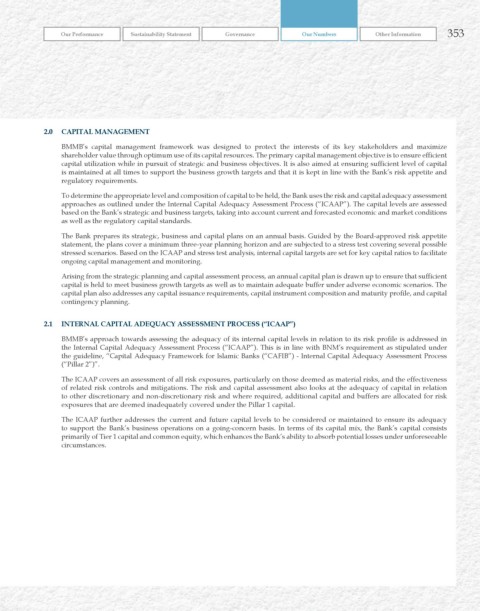Page 355 - Bank-Muamalat-AR2020
P. 355
353
Our Performance Sustainability Statement Governance Our Numbers Other Information
2.0 CAPITAL MANAGEMENT
BMMB’s capital management framework was designed to protect the interests of its key stakeholders and maximize
shareholder value through optimum use of its capital resources. The primary capital management objective is to ensure efficient
capital utilization while in pursuit of strategic and business objectives. It is also aimed at ensuring sufficient level of capital
is maintained at all times to support the business growth targets and that it is kept in line with the Bank’s risk appetite and
regulatory requirements.
To determine the appropriate level and composition of capital to be held, the Bank uses the risk and capital adequacy assessment
approaches as outlined under the Internal Capital Adequacy Assessment Process (“ICAAP”). The capital levels are assessed
based on the Bank’s strategic and business targets, taking into account current and forecasted economic and market conditions
as well as the regulatory capital standards.
The Bank prepares its strategic, business and capital plans on an annual basis. Guided by the Board-approved risk appetite
statement, the plans cover a minimum three-year planning horizon and are subjected to a stress test covering several possible
stressed scenarios. Based on the ICAAP and stress test analysis, internal capital targets are set for key capital ratios to facilitate
ongoing capital management and monitoring.
Arising from the strategic planning and capital assessment process, an annual capital plan is drawn up to ensure that sufficient
capital is held to meet business growth targets as well as to maintain adequate buffer under adverse economic scenarios. The
capital plan also addresses any capital issuance requirements, capital instrument composition and maturity profile, and capital
contingency planning.
2.1 INTErNAL CAPITAL ADEquACy ASSESSMENT PrOCESS (“ICAAP”)
BMMB’s approach towards assessing the adequacy of its internal capital levels in relation to its risk profile is addressed in
the Internal Capital Adequacy Assessment Process (“ICAAP”). This is in line with BNM’s requirement as stipulated under
the guideline, “Capital Adequacy Framework for Islamic Banks (“CAFIB”) - Internal Capital Adequacy Assessment Process
(“Pillar 2”)”.
The ICAAP covers an assessment of all risk exposures, particularly on those deemed as material risks, and the effectiveness
of related risk controls and mitigations. The risk and capital assessment also looks at the adequacy of capital in relation
to other discretionary and non-discretionary risk and where required, additional capital and buffers are allocated for risk
exposures that are deemed inadequately covered under the Pillar 1 capital.
The ICAAP further addresses the current and future capital levels to be considered or maintained to ensure its adequacy
to support the Bank’s business operations on a going-concern basis. In terms of its capital mix, the Bank’s capital consists
primarily of Tier 1 capital and common equity, which enhances the Bank’s ability to absorb potential losses under unforeseeable
circumstances.

